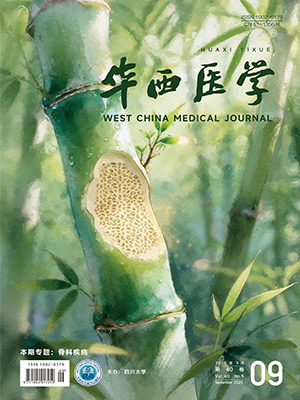| 1. |
Mishra SK, Millman SE, Zhang L. Metabolism in acute myeloid leukemia: mechanistic insights and therapeutic targets. Blood, 2023, 141(10): 1119-1135.
|
| 2. |
Bian X, Liu R, Meng Y, et al. Lipid metabolism and cancer. J Exp Med, 2021, 218(1): e20201606.
|
| 3. |
Lo Presti C, Yamaryo-Botté Y, Mondet J, et al. Variation in lipid species profiles among leukemic cells significantly impacts their sensitivity to the drug targeting of lipid metabolism and the prognosis of AML patients. Int J Mol Sci, 2023, 24(6): 5988.
|
| 4. |
Ouyang L, Qiu D, Fu X, et al. Overexpressing HPGDS in adipose-derived mesenchymal stem cells reduces inflammatory state and improves wound healing in type 2 diabetic mice. Stem Cell Res Ther, 2022, 13(1): 395.
|
| 5. |
Shao F, Mao H, Luo T, et al. HPGDS is a novel prognostic marker associated with lipid metabolism and aggressiveness in lung adenocarcinoma. Front Oncol, 2022, 12: 894485.
|
| 6. |
Solanki R, Zubbair Malik M, Alankar B, et al. Identification of novel biomarkers and potential molecular targets for uterine cancer using network-based approach. Pathol Res Pract, 2024, 260: 155431.
|
| 7. |
Qian F, Arner BE, Kelly KM, et al. Interleukin-4 treatment reduces leukemia burden in acute myeloid leukemia. FASEB J, 2022, 36(5): e22328.
|
| 8. |
Johnson AL, Edson KZ, Totah RA, et al. Cytochrome P450 ω-hydroxylases in inflammation and cancer. Adv Pharmacol, 2015, 74: 223-262.
|
| 9. |
Chen L, Tang S, Zhang FF, et al. CYP4A/20-HETE regulates ischemia-induced neovascularization via its actions on endothelial progenitor and preexisting endothelial cells. Am J Physiol Heart Circ Physiol, 2019, 316(6): H1468-H1479.
|
| 10. |
Su M, Chang YT, Hernandez D, et al. Regulation of drug metabolizing enzymes in the leukaemic bone marrow microenvironment. J Cell Mol Med, 2019, 23(6): 4111-4117.
|
| 11. |
De la Garza-Salazar F, Peña-Lozano SP, Gómez-Almaguer D, et al. Orbital myeloid sarcoma treated with low-dose venetoclax and a potent cytochrome P450 inhibitor. J Oncol Pharm Pract, 2023, 29(2): 493-497.
|
| 12. |
Panneerselvam S, Yesudhas D, Durai P, et al. A combined molecular docking/dynamics approach to probe the binding mode of cancer drugs with cytochrome P450 3A4. Molecules, 2015, 20(8): 14915-14935.
|
| 13. |
Summerlin J, Wells DA, Anderson MK, et al. A review of current and emerging therapeutic options for hemophagocytic lymphohistiocytosis. Ann Pharmacother, 2023, 57(7): 867-879.
|
| 14. |
Nguyen NHK, Rafiee R, Tagmount A, et al. Genome-wide CRISPR/Cas9 screen identifies etoposide response modulators associated with clinical outcomes in pediatric AML. Blood Adv, 2023, 7(9): 1769-1783.
|
| 15. |
Houten SM, Denis S, Argmann CA, et al. Peroxisomal L-bifunctional enzyme (Ehhadh) is essential for the production of medium-chain dicarboxylic acids. J Lipid Res, 2012, 53(7): 1296-1303.
|
| 16. |
谢思雨, 李淼生, 江峰乐, 等. EHHADH 是肝细胞癌脂肪酸代谢通路的关键基因: 基于转录组分析. 南方医科大学学报, 2023, 43(5): 680-693.
|
| 17. |
Stevens BM, Jones CL, Pollyea DA, et al. Fatty acid metabolism underlies venetoclax resistance in acute myeloid leukemia stem cells. Nat Cancer, 2020, 1(12): 1176-1187.
|
| 18. |
Farge T, Saland E, de Toni F, et al. Chemotherapy-resistant human acute myeloid leukemia cells are not enriched for leukemic stem cells but require oxidative metabolism. Cancer Discov, 2017, 7(7): 716-735.
|
| 19. |
Fu C, Kou R, Meng J, et al. m6A genotypes and prognostic signature for assessing the prognosis of patients with acute myeloid leukemia. BMC Med Genomics, 2023, 16(1): 191.
|
| 20. |
Zhou L, Jia X, Shang Y, et al. PRMT1 inhibition promotes ferroptosis sensitivity via ACSL1 upregulation in acute myeloid leukemia. Mol Carcinog, 2023, 62(8): 1119-1135.
|




